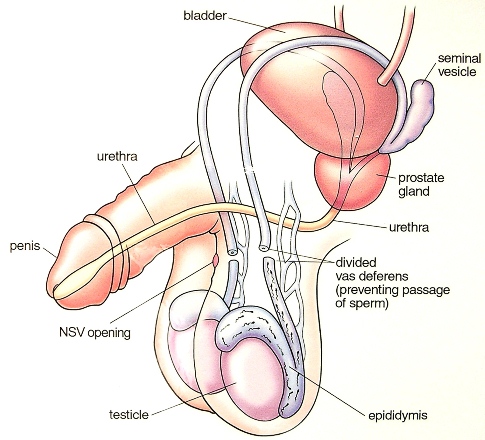The vasectomy program is partnered with the mission group No-scalple Vasectomy Inc. Dr. Shu participates in the vasectomy mission every year.
Developed as a means of contraception very early in the early 20th century, and popular (500,000 procedures per year in the USA) since the 1950’s, vasectomy is a dependable method of birth control for men who think they will never want any or any more children. It is a simple 15 minute procedure performed in a doctor’s office or clinic with a local anesthetic. The objective is to prevent sperm from entering the semen, 95% of which is support fluid made by glands called the prostate and seminal vesicles, located in the pelvis behind and beneath the bladder.

Sperm are made in the testes. From each testis, sperm move through a long curled-up tube behind the testis (the epididymis) wherein they become mature. From there, they swim up a foot-long tube (the vas) which guides them up to the channel (urethra) through which men urinate and ejaculate. Just before entering the urethra, the left and right vas tubes are enlarged, and it is here, behind the bladder, where many sperm are stored between ejaculations. The easiest place to access the vas tubes is just above the testes where the vas tubes are just beneath the thin scrotal skin, easy to feel and very mobile.
During no-scalpel vasectomy (NSV), special instruments are used to perform the procedure through a single tiny access-opening on the front side of the scrotum. The 1/4-inch slit usually seals within hours, so no stitches are needed. Through this one opening, each vas (left & right) is divided about one inch above each testis, where it is just beneath the thin scrotal skin and very easy to access. A tiny section is lifted through the small opening, it is divided, one end is cauterized, and the divided ends are kept out of alignment, by closing the vas sheath between the 2 ends with a suture or tiny clip so the ends won’t grow back together (a technique called fascial interposition).
The portions of the vas tubes within the pelvis still contain live sperm until they are all released. About 95% of men are sperm-free after 20 ejaculations AND 12 weeks. In 5% of men, the semen may still contain some sperm, but usually few in number and not active enough to cause a pregnancy. If you wish to know whether you are one of the 1 in 2000 men whose vasectomy will fail early (during the 3 months after the vasectomy), you should have a semen sample checked 3 months after the vasectomy. You should use other forms of birth control for 3 months after the vasectomy, or for a greater degree of confidence, until it is confirmed by microscopic examination that the semen is sperm-free.
Sperm are still made by the testes but can no longer pass up through the vas tubes and into the semen made by the prostate and seminal vesicles. So the body adjusts: white blood cells ingest and digest the retained sperm, recycling the proteins back into the system for use in other body functions.
After vasectomy, most men notice:
- No change in the semen
- No change in sex drive
- No change in climax sensation
- No change in the testes or scrotum
- No change in erection
Advantages of vasectomy:
Limitations of vasectomy:
Instructions Before Vasectomy
Understand the “Instructions Following Vasectomy” below so that you know what to expect.
1. Please shave the underside of the penis and the front wall of the scrotum, preferably before the day of the procedure. A bit of alcohol is used to clean the skin before use of the MadaJet® and it can sting slightly right after a fresh shave if the skin is chafed.
2. Take a shower or bath on the morning of your vasectomy.
3. Use no powder or deodorant in the genital area on the day of your procedure.
4. Wear tight underwear on the day of the vasectomy.
5. Be prepared to sign an operative consent sheet (part of the PDF file in the paragraph above) upon your arrival.
6. If possible, arrange to have someone drive you home. If you must drive yourself, a flat tire or fender bender could lead to complications. Plan to do nothing but
7. recline at home (sofa or bed) on the afternoon and evening of the vasectomy.
8. Do not take any aspirin-containing medication for five days before the procedure.
9. Eat before your procedure, a normal breakfast or lunch. Nervous men who do not eat beforehand are more likely to become lightheaded during or after their vasectomies.
Instructions Following Vasectomy
1. Spend a quiet evening at home, reclining in bed or on the sofa. Minimize activity.
2. You may take acetaminophen (Tylenol® or generic) for discomfort. Avoid aspirin for 2 days after the vasectomy.
3. No need for ice packs.
4, You may take a daily shower starting the morning after the procedure. Wear tight underwear whenever you are up and around for the next 2 days, during sports for the next 7 days.
5. On the day after the procedure, you may walk and drive as much as you like, but no sports, heavy work, swimming, or cycling. Men with non-strenuous jobs may work the next day.
6. Two days after the procedure, you may return to rather strenuous work and regular activities wearing tight underwear. Wait 3 days for aggressive sports like basketball and tennis, and wear tight underwear during sports for a week. If you are a weight lifter or runner, would may resume your workouts 2 days after the vasectomy, but on the first day back, do half of your usual workout, that is, half your usual reps with half your usual weight, and half your usual distance at half your usual speed. If you feel fine that night, resume your usual workout 3 days after the vasectomy. If a half-workout causes soreness, give it more time.
7. You should not ejaculate for one week after the procedure. It is uncommon but normal to have some blood in the semen for the first few ejaculations.
8. Since a tiny incision is made, a follow-up visit is not required. You will be given an NSVI person’s cell phone number and if you have undue discomfort or any concerns, you should call anytime after your vasectomy.
9. It is normal to have some discoloration of the skin (black and blue) around the puncture site a day or two after the vasectomy. Some men will develop considerable discoloration of the scrotum about 4 days after the vasectomy. Blood from the deep vasectomy site comes to the surface as a purplish-blue mark, gets darker and spreads out like an oil slick, then gradually dissipates.
10. Some men (about one in 20) will develop swelling and discomfort on one side, sometimes on both sides, starting anytime from 3 days to 3 months following vasectomy. This usually represents an exaggerated form of the normal inflammatory response necessary for sperm resorption and recycling. It is effectively managed with a 5-7 day course of ibuprofen 600 mg 3 times per day.
11. Twelve weeks and 20 ejaculations (number of ejaculations and number of weeks are both important) after your vasectomy, you may have your semen tested to be sure that it no longer contains sperm and that it is thereby safe to stop other forms of contraception. NSVI staff will provide instructions.
